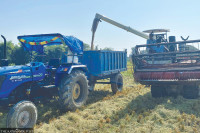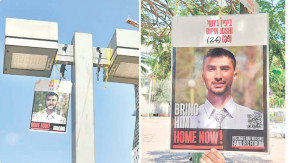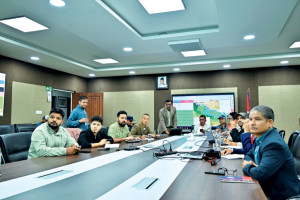National
Civil aviation ministry introduces unified rules to streamline airline operations
The new Air Service Management Regulation simplifies licensing, removes investment barriers, and sets clear categories for international operations.
Sangam Prasain
Nepal’s civil aviation ministry has introduced a new regulation aimed at consolidating and streamlining the airline industry's legal framework. This comes a decade after the regulation was first proposed.
The new Air Service Management Regulation 2025 was officially published in the Nepal Gazette on April 21.
A key change in the regulation is the removal of the provision that required new international airline companies to acquire a licence through competitive bidding.
Under the old rules, the ministry issued a public notice and invited interested companies to participate in competitive bidding whenever it decided that a new international airline was needed.
This process typically allowed for the issuance of two licences for international passenger airlines and one for cargo operations, occurring every three to five years, depending on the demand.
According to a tourism ministry official, this system had become a barrier to investment.
Now, under the new regulation, the process has been simplified, allowing companies to apply directly for a licence based on their submitted documents without having to wait for a bidding announcement.
The regulation also lifts restrictions on domestic airlines seeking to enter the international market.
Previously, such airlines were required to have five years of domestic flying experience and a fleet of at least three aircraft before they could apply for international routes. This requirement has now been replaced with a provision allowing domestic airlines to secure international licences by demonstrating adequate investment in the company.
The ministry spent ten years preparing this comprehensive regulation, which now legally categorises international airline licences into three distinct classes—A, B, and C.
Class A licence applies to companies operating at least three aircraft, each weighing over 125 tonnes. These typically include wide-body planes such as the Airbus A330 or Boeing 777.
Class B licences cover companies with three aircraft weighing between 40 and 125 tonnes, such as the Airbus A320 or Boeing 757.
Class C licences are designated for airlines operating planes with a maximum takeoff weight of under 40 tonnes, including smaller aircraft such as the ATR and CRJ series.
Corresponding to these licence classes, the regulation outlines specific capital requirements.
A Class A airline must have a paid-up capital of Rs1.25 billion, while a Class B airline requires Rs1 billion, and a Class C airline requires Rs750 million. Fixed-wing domestic operators must meet a capital requirement of Rs750 million, helicopter companies Rs500 million, and aviation training schools Rs100 million.
Another significant stipulation in the regulation requires domestic airlines to expand their fleet to three aircraft within five years of receiving their licence.
Each licence issued under this regulation will be valid for four years. If a permit is not renewed within this period, the company will be granted a one-year grace period during which they can still renew it by paying a penalty.
Failure to renew within the extension period will result in the licence’s automatic revocation.
Officials noted that the previous legal framework lacked clarity regarding the licensing process, but the new regulation addresses this gap by clearly outlining the procedures and requirements.
Additionally, it incorporates the clauses of the air service agreement into the main regulation, giving it a more comprehensive structure. This includes provisions related to flight designations, code-sharing agreements with foreign airlines, and other operational policies.
The regulation also touches on matters related to foreign personnel employed in Nepal’s airline industry. It includes provisions for visas and visa extensions for foreign employees working in aviation companies within Nepal.
Furthermore, the regulation requires all foreign airlines operating in Nepal to conduct their commercial transactions through officially appointed general sales agents (GSA) based in Nepal. Any airline that does not currently operate through a GSA must appoint one within a year and notify the ministry of the arrangement.
Audit transparency is another point emphasised in the new rules. All companies associated with Nepal’s aviation industry are now required to submit their audited financial reports within three months of the end of the fiscal year.
These regulatory changes come at a time when Nepal’s aviation sector is experiencing significant growth in infrastructure, including the construction of two new international airports, but has struggled to attract new airline companies.
International passenger traffic at the Tribhuvan International Airport in Kathmandu has increased nearly fivefold since 2000.
In 2024 alone, the airport recorded an unprecedented 4.96 million international travellers. This increase was fuelled by rising tourist numbers, a growing population of Nepali workers heading abroad, and a surge in students pursuing education overseas.
Following the challenges posed by the Covid-19 pandemic, the rebound in air travel has been remarkable. The surge in outbound travel has significantly contributed to the growth.
On the domestic front, air travel has also seen a recovery despite previous setbacks caused by economic issues, high taxes, and multiple accidents in 2023. In 2024, domestic passenger traffic experienced a 7.72 percent year-on-year growth.
This boost was particularly noticeable during the festive season, when intense rainfall in late September temporarily shut down all major highways leading to the Kathmandu Valley, forcing many travellers to rely on air transport.
In total, Nepal’s domestic airlines, comprising eight fixed-wing operators and eleven helicopter companies, transported a record 4.47 million passengers in 2024, the highest number ever recorded in the country's aviation history.




 21.12°C Kathmandu
21.12°C Kathmandu















